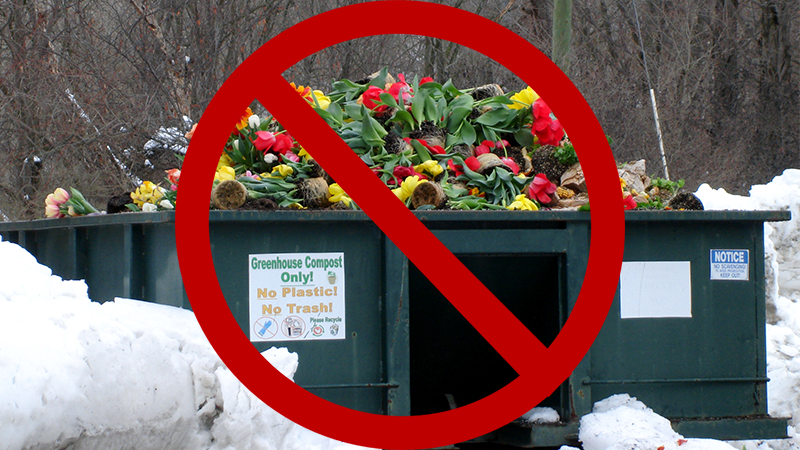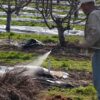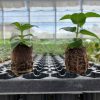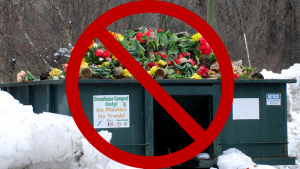
No grower wants to see their hard work end up in the dumpster.
As we enter the beginning of Spring 2020, I suspect a universal grower objective for the new year is to reduce shrink. This goal is motivated by the very basic objective of reducing costs to improve profitability. Let’s discuss how shrink impacts several stages in the horticultural supply chain and how mycorrhizae can help reduce shrink.
For a young plant producer, it can be the difference between what they seed or stick and the quantity of units they sell. For a seeded product, it equates to how much a grower has to over-seed in growing extra units or in double or triple seeding to produce the desired number of units they have on order. For the liner producer, it is the extra growing units that need to be stuck so that you have enough overage to cover the needed production order. Or it can be selling a tray with a guaranteed minimum number of viable plants that is below the cell count. It is important to also remember that the cost of plant material has increased dramatically, so the extra genetics a young plant grower needs to grow to cover their orders can be substantial.
Now you are probably wondering how can mycorrhizae help reduce shrink for the young plant producer? Once a plug begins stage 1 and the radicle emerges into the soil, the root tip can then come into contact with mycorrhizae in the soil. The mycorrhizae could have been applied via a soil incorporation or a drench. As the seedling moves into stage 2 the chance of this occurrence increases as the rooting mass increases. The same is true with a cutting once the first root starts to emerge from the cutting. The root tip then releases an exudate that then initiates the symbiosis between the seedling/cutting and the mycorrhizae. Full symbiosis can take up to four weeks before the plant starts to substantially benefit from their mycorrhizal relationship. University research has shown that some species of mycorrhizae are quicker to establish the symbiosis and can create the connection within 10-14 days. Plugs and cuttings benefit from being grown in a mycorrhizal relationship because the mycorrhizae help the young plants to develop better and stronger root systems that increases the number of sellable plant (greater survivability), potentially reduces the size of the plant buffer (reduces costs) and decreases shrink.
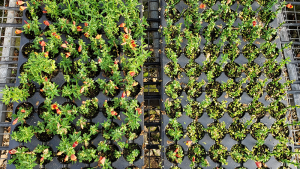
After this 12-week trial, the MycoApply treated Cytisus tray (left) is much heartier and healthier than the untreated control (right).
Young Plant Grower – Key Factors to Consider when Using Mycorrhizae:
- Start the Clock – Apply mycorrhizae before germination or at time of sticking to minimize the time needed for the plants to benefit from mycorrhizal symbiosis and for you as the grower to start benefiting.
- Multiple Species – Consider using a product with more than one mycorrhizal species to maximize the potential for earlier benefits from the mycorrhizal relationship. All MycoApply® Horticulture Products feature a four species endomycorrhizal consortium.
- Improved Root Network – Mycorrhizae will not cause a cutting to initiate rooting (like an auxin), but it will work to strengthen and increase the root mass of the plug/cutting helping it to survive and thrive in the greenhouse.
- Lowest Cost Option – Application at time of propagation is the more cost-effective method for applying mycorrhizae, since the soil volume is the smallest and the mycorrhizae treated plants transfer their relationship ever time the plant is transplanted into a larger container or into the landscape.
- Added Value – For those young plant producers that have a shorter crop time, in addition to you benefiting from the mycorrhizal boost during your production, you are also adding value to our finished propagation material that will benefit the finished grower and the retailer and/or landscaper. Mycorrhizae could be the difference-maker in helping you grow your business and separate yourself from the competition.
- See the Difference during Finishing – Since the soil volume is small in a propagation cell, the mycorrhizal benefits will not necessarily be visual to the grower. These benefits will become more visually distinct in a larger container. Typically, it can be up to eight weeks from the time symbiosis starts before a grower starts to see visual benefits.
Takeaway – Young Plant Growers will have less shrink when they use mycorrhizae during production since it can lead to higher survivability of the seedlings and cuttings.
For the finished grower, your shrink is the difference between the number of plants you start with and the number of plants you sell and get paid for by your retail or landscape customer. There is no difference between a seed propagule and a rooted liner in this case other than the cost of the plant material is higher for the liner. It is important to remember the higher the input costs, the greater the loss for any plant lost to shrink.
Now you are probably wondering how can mycorrhizae help reduce shrink for the finished grower? One of the primary benefits of mycorrhizae is that it helps plants overcome transplant shock. So, one of the first benefits a finished grower will realize is that when they plant out their plugs and liners, the plants will have a higher transplant survivability (reduced costs). Growers will also experience a crop that has greater uniformity. Greater crop uniformity leads to shorter crop time (reduced costs) and more “bench run” harvesting (reduced costs). Stress is also reduced during transport, so the plants come out of the delivery truck ready for sale (reduced costs). Shelf life is increased as the plants are better able to uptake water and nutrients resulting in less plant losses (reduced costs) and higher sell through. Increased survivability and performance in the landscape leads to less plant returns (reduced costs). Mycorrhizal usage also can reduce fertilizer, pesticide, and water costs. The reduction of these costs reduces the costs of plants that do not sell. Finished plants benefit from being grown in a mycorrhizal relationship because the mycorrhizae help the plant to develop a better and stronger root system that in turn allows the plant to be more effective and efficient at the uptake of water and nutrients. A plant with these advantages can handle stress better and is more likely to sold by the grower which ultimately decreases shrink.
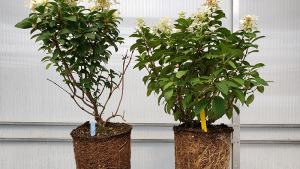
In this hydrangea overwintering trial, the untreated plants (left) had a 25% mortality rate, while the MycoApply treated plants (right) had zero mortality.
Finish Grower – Key Factors to Consider when Using Mycorrhizae:
- Start the Clock – If the plugs/liners you purchase have not been treated with mycorrhizae (or if you are unsure if they have), immediately treat them with a drench or plug dip. This effort will minimize the time needed for the plants to benefit from mycorrhizal symbiosis. This also allows for the symbiosis clock to begin ticking even if you hold the plugs before you transplant them. If the young plant producer you purchase from includes mycorrhizal usage (preferably the multi species MycoApply® products) in their production protocol, you are good to go and do not need to retreat.
- Multiple Species – Consider using a product with more than one mycorrhizal species to maximize the potential for earlier benefits from the mycorrhizal relationship. All MycoApply® Horticulture Products feature a four species endomycorrhizal consortium.
- Production Automation – Young plants grown with mycorrhizae will have a stronger root system making them a better candidate for automatic transplanters.
- Lowest Cost Option for Finished Growers – A drench/plug dip prior to transplanting is the most cost-effective method for applying mycorrhizae for the finished grower, since the soil volume is the smallest and the mycorrhizae treated plants maintain their symbiotic relationship no matter how many times the plant is transplanted into a larger container or into the landscape.
- Increased Scans – For those growers working with retailers that pay you when the product is sold, you live or die by your scan (you want it high) and shrink rates (you want it low). You want your plants to attract attention and drive customer demand so your sell-through rates are at their maximum. Additionally, you want the retail customer to be happy with your plant, so they don’t return the product for replacement, or in other words reduce your sales. Mycorrhizal usage allows the plant to be retail-ready during unloading at the retailer and then it works to maintain the performance of the plant for an improved shelf life. Both of these traits lead to more scans and less returns.
- See the Difference – Benefits will become more visually distinct once the transplants are moved to a larger container. Typically, it can be up to eight weeks from the time symbiosis starts before a grower starts to see visual benefits.
Takeaway – Finished Growers will have less shrink when they use mycorrhizae during production since it can lead to higher survivability and sell through of the finished crop. More plants sold and less plants lost.
It is important to think of shrink as a lost opportunity to make money and increase your profitability. Mycorrhizae are another tool in the grower’s tool box that can help growers achieve success in reducing shrink.
Article by: Blair Busenbark
Mycorrhizal Applications – Sales & Commercial Marketing Manager
January 15, 2020

